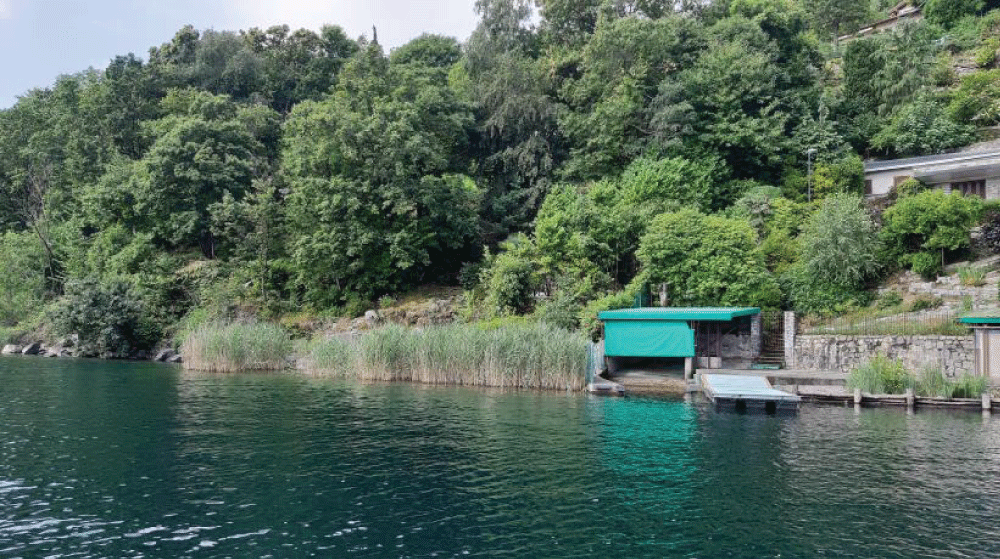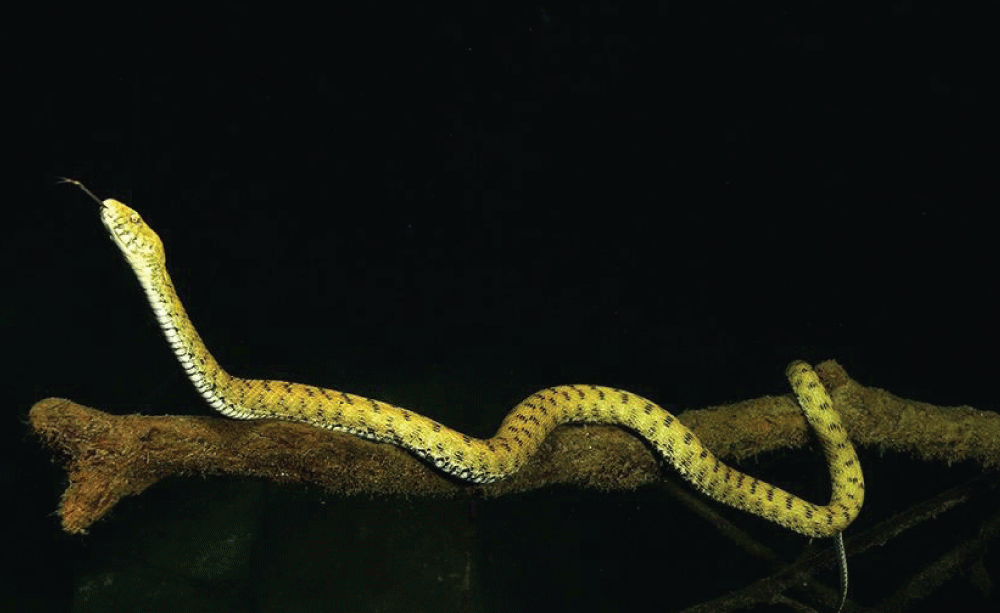
Into the Deep: Diving Record for the Dice Snake Natrix tessellata (Laurenti, 1768) in Lake Orta, NW Italy
Ecosystem Science Zoology收到 17 Apr 2024 接受 01 May 2024 在线发布 02 May 2024
ISSN: 2995-8067 | Quick Google Scholar
Next Full Text
Wishful Thinking about Consciousness
Previous Full Text
Challenge and Readiness to Implemented Geothermal Energy in Indonesia


收到 17 Apr 2024 接受 01 May 2024 在线发布 02 May 2024
Many snakes live close to water, with several groups displaying morphological, physiological, or behavioral adaptions to aquatic environments. Although marine snakes have been found at depths beyond 200 m, freshwater snakes are rarely reported at depths larger than a few meters. Here we report freshwater depth records for the dice snake Natrix tessellata, an aquatic snake belonging to the family Natricidae. Dice snake was observed at depths down to 17 m, including in habitats below the thermocline, in Lake Orta (Northern Italy). These observations open new perspectives related to the biology and physiology of Palearctic freshwater snakes belonging to the family Natricidae.
More than 3000 snake species are known globally. Many species live close to water, and around 5% are considered strictly aquatic []. Elapid sea snakes and the Homalopsidae snakes are particularly well adapted to the aquatic environment. Both groups have several morphological and physiological adaptations linked to their aquatic life [-]. Elapid sea snakes are strictly marine snakes, with depth records beyond 200 meters reported for the genus Hydrophis []. Homalopsidae, on the other hand, include marine as well as brackish and freshwater species [].
Most other freshwater snake species belong to the Natricidae and Xenodontida subfamilies with both groups including both terrestrial and aquatic species. Natricidae snakes are widely distributed in the Palearctic and Nearctic Regions and include over 250 species. Some species, such as the dice snake Natrix tessellata, are strictly aquatic, inhabiting several different freshwater habitats. Compared to other species of the genus Natrix, dice snake show particularly pronounced morphofunctional and behavioural adaptations to aquatic life [-].
The dice snake lives its entire life along the banks in both lentic and moderately lotic environments. It hunts fish underwater [,] and thermoregulates within the aquatic environment []. As for other freshwater snake species, little is known about its depth use. It has been reported not to move far from the banks of the water body [,], Nevertheless, Gruschwitz, et al. [], reported occurrences at 12 m depths in lakes in Switzerland and Northern Italy. Even these snakes, however, were never observed below the thermocline (at 15 m depth) in these stratified lakes.
Based on observations made by divers in Lake Orta (NW Italy), we here report dice snake occurrences down to depths of up to 17 m, including two observations below the thermocline.
Data was collected using a Citizen Science protocol in collaboration with the Deep Green Divers Association of Pella (Novara Province). Volunteer divers were trained on species identification and depth reporting, and supplied with data collection sheets. Data collection sheets included location (site name and coordinates), depth (m), and temperature (°C) for each dice snake observation. Data collection sheets were made available both at the Association’s headquarters and in a group chat. In total, 16 independent dice snake observations were reported (Table 1).
 Table 1: Dice snake (Natrix tessellata) observations reported by volunteers from Deep Green Divers Association of Pella (Novara Province). The table includes the observer (full name), date, location, coordinates, depth, and temperature.
Table 1: Dice snake (Natrix tessellata) observations reported by volunteers from Deep Green Divers Association of Pella (Novara Province). The table includes the observer (full name), date, location, coordinates, depth, and temperature.Figure 1 shows the Punta Grunf locality and Figure 2 shows a specimen observed on date 20th September 2020. at the depth of 17 m.
 Figure 1: Punta Grunf, Lake Orta. Near this location, a specimen was observed at a depth of 17 m. Photo by Paola Viviana Trovò.
Figure 1: Punta Grunf, Lake Orta. Near this location, a specimen was observed at a depth of 17 m. Photo by Paola Viviana Trovò. Figure 2: Specimen of Natrix tessellata swimming at a depth of 17 m. Photo taken with flash by Alessio Viora.
Figure 2: Specimen of Natrix tessellata swimming at a depth of 17 m. Photo taken with flash by Alessio Viora.On the basis of these data, we conclude that the dice snake displays a more extensive depth range than previously reported, including sites at the bottom of the lake, under the thermocline (observations of 20th Sept. 2020 and 19th Aug, 2021). During summer, the thermocline in Lake Orta is located at a depth of about 10 m - 15 m. Indeed, one of the observers PVT, on 19th August 2021, reported that the observed specimen at a depth of 11 m was even swimming along the bottom of the lake towards even deeper areas.
The lack of scientific literature on the use of deeper waters in Natrix snakes limits our ability to explain this behavior. It is, however, unlikely that the snake descend to such depths to feed. The dice snake is almost completely ichthyophagous, and preys on several small-sized fish species [] which are decidedly more abundant and easier to catch in shallow waters along the shore. Another explanation could be that the snakes exploit deeper water for thermoregulation. Diving deep allows the snake to lower the temperature of its environment substantially, even over 20 °C, in a short time.
Alongside adaptations to brackish and even marine waters in this species (Strugariu, et al. 2011), the ability to move in very deep waters highlights its ability to adapt to a diverse range of aquatic environments. It also opens up new research perspectives. Climate change is forecasted to increase lake temperatures, particularly in superficial layers, perhaps pushing both fish and snakes to colder, deeper waters. The observation of snakes at depths even greater than 10 meters suggests that deeper dives may constitute a coping mechanism for the species. More work, however, is needed. Both behavior and time spent at larger depths remains unknown. For example, higher pressure at a larger depth could limit large-depth excursion.
Lastly, this small Citizen Science project underlines the important contribution a small group of properly trained volunteers can make to the expansion of our knowledge about the natural world. In addition to the data collected, the incentive to observe likely leads to greater awareness of our surroundings and, hopefully, greater respect for nature.
The Dice Snake Natrix tessellata is protected by the European Community and is included in both the Bern Convention and Annex IV of the 92/43 EEC “Habitats” Directive.
The authors sincerely thank Prof. Dr. Wolfgang Böhme and Dr. Daniel Nyqvist for their valuable contributions. Special thanks also to Alessio Viora for kindly providing the photo of the snake at 17 m depth and to all the volunteers of the Deep Green Divers Association.
Pauwels O, Wallach V, David P. Global diversity of snakes (Serpentes; Reptilia) in freshwater. Hydrobiologia. 2008; 595(1):599-605.
CAREY JE, WRIGHT EA. Isolation of the neurotoxic component of the venom of the sea snake, Enhydrina schistosa. Nature. 1960 Jan 9;185:103-4. doi: 10.1038/185103b0. PMID: 13807688.
Dunson WA, Packer RK, Dunson MK. Sea Snakes: An Unusual Salt Gland under the Tongue. Science. 1971 Jul 30;173(3995):437-41. doi: 10.1126/science.173.3995.437. PMID: 17770448.
Graham JB. Aquatic respiration in the sea snake Pelamis platurus. Respir Physiol. 1974 Jul;21(1):1-7. doi: 10.1016/0034-5687(74)90002-4. PMID: 4846936.
Graham JB, Gee JH, Robison FS. Hydrostatic and gas exchange functions of the lung of the sea snake Pelamis platurus. Comp Biochem Physiol. 1975; 50(3):477–482.
Schwenk K. Comparative anatomy and physiology of chemical senses in nonavian aquatic reptiles. Berkeley: University of California Press. 2008. DOI:10.1525/california/9780520252783.003.0005
Crowe-Riddell J, D'Anastasi B, Nankivell J, Rasmussen A, Sanders K. First records of sea snakes (Elapidae: Hydrophiinae) diving to the mesopelagic zone (>200 m). Austral Ecology. 2019; 44:10.1111/aec.12717
Murphy JC. Homalopsid Snakes Evolution In The Mud. Krieger Publishing Company Melbourne (FL). 2007; 296.
Schaeffer F. Underwater vision in semi-aquatic european snakes. Naturwissenschaften. 1991; 78: 373-375.
Brecko J, Vervust B, Herrel A, Van Damme R. Head Morphology and Diet in the Dice Snake (Natrix tessellata) in The Dice Snake, Natrix tessellata: Biology, Distribution and Conservation of a Palaearctic Species. Mertensiella. Konrad Mebert Editor, Rheinback. 2011; 20-29.
Scali S. Ecological Comparison of the Dice Snake (Natrix tessellata) and the Viperine Snake (Natrix maura) in Northern Italy. in The Dice Snake, Natrix tessellata: Biology, Distribution andConservation of a Palaearctic Species. Mertensiella. Konrad Mebert Editor, Rheinback. 2011; 131- 144.
Luiselli L, Rugiero L. Food niche partitioning by water snakes (Genus Natrix) at a freshwater environment in central Italy. – Journal of Freshwater Ecology. 1991; 6: 439–444.
Gruschwitz M, Lenz S, Mebert K, Lanka V. Natrix tessellata (Laurenti, 1768) – Würfelnatter. – in Böhme, W. (Ed.): Handbuch der Reptilien und Amphibien Europas, Vol. 3/Schlangen II. – AULA-Verlag, Wiesbaden, Germany. 1999; 581– 644.
Litvinov N, Bakiev AG, Mebert K. Thermobiology and Microclimate of the Dice Snake at its Northern Range Limit in Russia. Mertensiella. 2011; 18:330-335.
Böhme W. Handbuch der reptilien und amphibien Europas. Band 3/IIA: Schlangen II. Aula-Verlag GmbH, Wiebelsheim. 1999; ISBN: 9783891046166.
Janev B, Mebert K. Ecological Partitioning between Dice Snakes (Natrix tessellata) and Grass Snakes (Natrix natrix) in Southern Croatia. 2011; 18:225-233.
Strugariu A, Gherghel I, Ghira I, Covaciu-Marcov SD, Mebert C. Distribution, Habitat Preferences and Conservation of the Dice Snake (Natrix tessellata) in Romania. in The Dice Snake, Natrix tessellata: Biology, Distribution and Conservation of a Palaearctic Species. Mertensiella. Konrad Mebert Editor, Rheinback. 2011; 272- 287.
Bovero S, Trovò PV. Into the Deep: Diving Record for the Dice Snake Natrix tessellata (Laurenti, 1768) in Lake Orta, NW Italy. IgMin Res. May 02, 2024; 2(5): 299-0. IgMin ID: igmin179; DOI: 10.61927/igmin179; Available at: igmin.link/p179
任何您分享以下链接的人都可以阅读此内容:
1Zirichiltaggi” Sardinia Wildlife Conservation NGO, Sassari (SS), Italy
2Management Body of the Protected Areas of Ticino and Lake Maggiore, Cameri (NO), Italy
Address Correspondence:
Stefano Bovero, “Zirichiltaggi” Sardinia Wildlife Conservation NGO - Sassari (SS), Italy, Email: [email protected]
How to cite this article:
Bovero S, Trovò PV. Into the Deep: Diving Record for the Dice Snake Natrix tessellata (Laurenti, 1768) in Lake Orta, NW Italy. IgMin Res. May 02, 2024; 2(5): 299-0. IgMin ID: igmin179; DOI: 10.61927/igmin179; Available at: igmin.link/p179
Copyright: © 2024 Bovero S, et al. This is an open access article distributed under the Creative Commons Attribution License, which permits unrestricted use, distribution, and reproduction in any medium, provided the original work is properly cited.
 Figure 1: Punta Grunf, Lake Orta. Near this location, a spec...
Figure 1: Punta Grunf, Lake Orta. Near this location, a spec...
 Figure 2: Specimen of Natrix tessellata swimming at a depth ...
Figure 2: Specimen of Natrix tessellata swimming at a depth ...
 Table 1: Dice snake (Natrix tessellata) observations report...
Table 1: Dice snake (Natrix tessellata) observations report...
Pauwels O, Wallach V, David P. Global diversity of snakes (Serpentes; Reptilia) in freshwater. Hydrobiologia. 2008; 595(1):599-605.
CAREY JE, WRIGHT EA. Isolation of the neurotoxic component of the venom of the sea snake, Enhydrina schistosa. Nature. 1960 Jan 9;185:103-4. doi: 10.1038/185103b0. PMID: 13807688.
Dunson WA, Packer RK, Dunson MK. Sea Snakes: An Unusual Salt Gland under the Tongue. Science. 1971 Jul 30;173(3995):437-41. doi: 10.1126/science.173.3995.437. PMID: 17770448.
Graham JB. Aquatic respiration in the sea snake Pelamis platurus. Respir Physiol. 1974 Jul;21(1):1-7. doi: 10.1016/0034-5687(74)90002-4. PMID: 4846936.
Graham JB, Gee JH, Robison FS. Hydrostatic and gas exchange functions of the lung of the sea snake Pelamis platurus. Comp Biochem Physiol. 1975; 50(3):477–482.
Schwenk K. Comparative anatomy and physiology of chemical senses in nonavian aquatic reptiles. Berkeley: University of California Press. 2008. DOI:10.1525/california/9780520252783.003.0005
Crowe-Riddell J, D'Anastasi B, Nankivell J, Rasmussen A, Sanders K. First records of sea snakes (Elapidae: Hydrophiinae) diving to the mesopelagic zone (>200 m). Austral Ecology. 2019; 44:10.1111/aec.12717
Murphy JC. Homalopsid Snakes Evolution In The Mud. Krieger Publishing Company Melbourne (FL). 2007; 296.
Schaeffer F. Underwater vision in semi-aquatic european snakes. Naturwissenschaften. 1991; 78: 373-375.
Brecko J, Vervust B, Herrel A, Van Damme R. Head Morphology and Diet in the Dice Snake (Natrix tessellata) in The Dice Snake, Natrix tessellata: Biology, Distribution and Conservation of a Palaearctic Species. Mertensiella. Konrad Mebert Editor, Rheinback. 2011; 20-29.
Scali S. Ecological Comparison of the Dice Snake (Natrix tessellata) and the Viperine Snake (Natrix maura) in Northern Italy. in The Dice Snake, Natrix tessellata: Biology, Distribution andConservation of a Palaearctic Species. Mertensiella. Konrad Mebert Editor, Rheinback. 2011; 131- 144.
Luiselli L, Rugiero L. Food niche partitioning by water snakes (Genus Natrix) at a freshwater environment in central Italy. – Journal of Freshwater Ecology. 1991; 6: 439–444.
Gruschwitz M, Lenz S, Mebert K, Lanka V. Natrix tessellata (Laurenti, 1768) – Würfelnatter. – in Böhme, W. (Ed.): Handbuch der Reptilien und Amphibien Europas, Vol. 3/Schlangen II. – AULA-Verlag, Wiesbaden, Germany. 1999; 581– 644.
Litvinov N, Bakiev AG, Mebert K. Thermobiology and Microclimate of the Dice Snake at its Northern Range Limit in Russia. Mertensiella. 2011; 18:330-335.
Böhme W. Handbuch der reptilien und amphibien Europas. Band 3/IIA: Schlangen II. Aula-Verlag GmbH, Wiebelsheim. 1999; ISBN: 9783891046166.
Janev B, Mebert K. Ecological Partitioning between Dice Snakes (Natrix tessellata) and Grass Snakes (Natrix natrix) in Southern Croatia. 2011; 18:225-233.
Strugariu A, Gherghel I, Ghira I, Covaciu-Marcov SD, Mebert C. Distribution, Habitat Preferences and Conservation of the Dice Snake (Natrix tessellata) in Romania. in The Dice Snake, Natrix tessellata: Biology, Distribution and Conservation of a Palaearctic Species. Mertensiella. Konrad Mebert Editor, Rheinback. 2011; 272- 287.